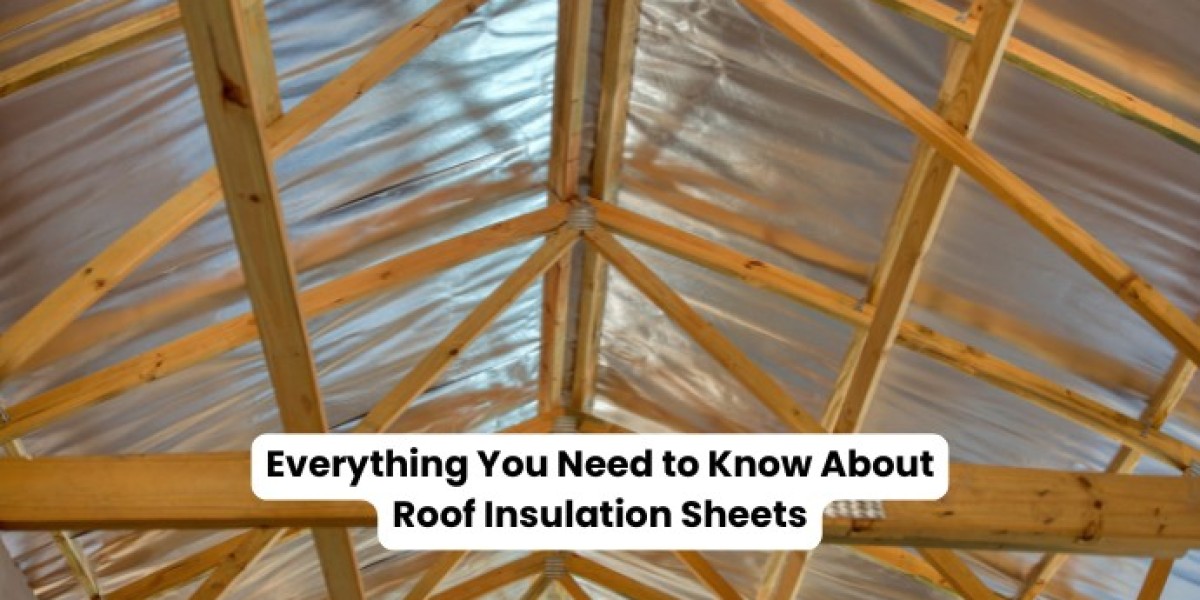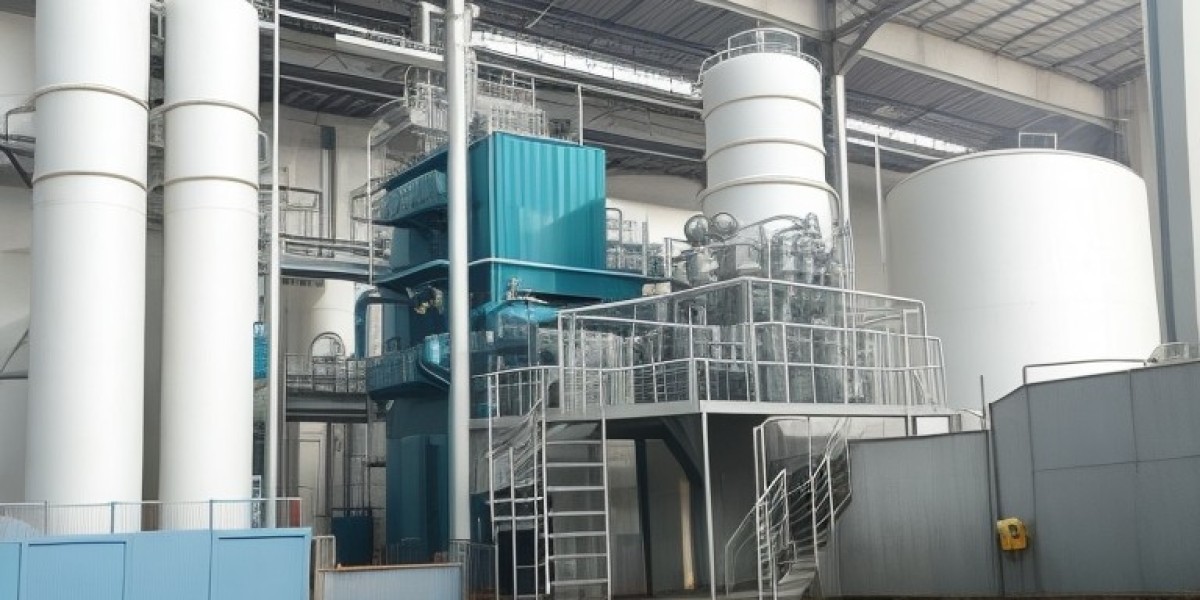A roof insulation sheet is a material designed to reduce heat transfer through a building's roof. In hot climates like India, where temperatures can soar, these sheets play a crucial role in keeping indoor spaces cool and energy-efficient. Roof insulation sheets are installed beneath or over the roof structure, creating a barrier that minimizes the amount of heat entering the building during summer and prevents heat loss in colder months.
Among the different types of roof insulation materials available, Aluminium Foil Insulation Sheets are rapidly gaining popularity due to their high thermal reflectivity, ease of installation, and durability. They provide an excellent solution for regulating indoor temperatures, especially in regions where extreme heat is a common concern.
Why Roof Insulation is Essential in India
India experiences a wide range of climates, from scorching summers to chilly winters, depending on the region. In hot states like Rajasthan and Gujarat, roof insulation becomes vital for maintaining comfortable indoor temperatures without over-relying on air conditioning, which can lead to hefty energy bills. Conversely, in colder areas, it helps retain heat indoors, reducing heating costs.
Installing roof insulation, particularly with aluminium foil sheets, helps:
- Reduce energy consumption: Less need for air conditioning or heating.
- Lower energy bills: A well-insulated roof can significantly decrease the need for cooling and heating appliances, leading to substantial savings.
- Improve comfort: Maintain a stable, comfortable indoor temperature, no matter the weather outside.
- Enhance eco-friendliness: By using less energy, you're contributing to reducing the carbon footprint of your home or building.
Types of Roof Insulation Sheets
There are various types of roof insulation sheets available, each with its own advantages and applications. Some of the most common types include:
Fiberglass Insulation Sheets:
Made from fine strands of glass, these are one of the most popular and affordable insulation materials. They trap air, providing effective thermal resistance, but can be irritating to install and less effective in extremely hot climates.
Polyurethane Foam Sheets:
These offer superior thermal resistance, especially for cold climates. However, they are more expensive and less eco-friendly due to their chemical composition.
Aluminium Foil Insulation Sheets:
These sheets are made of reflective aluminium foil, often combined with a foam or air bubble layer. This type of insulation is perfect for India’s hot climate, as it reflects radiant heat away from the building, keeping interiors cooler. The aluminium foil insulation sheet is lightweight, durable, and cost-effective, making it ideal for Indian homes and commercial buildings.
3. Aluminium Foil Insulation Sheet: The Ideal Choice for Roof Insulation
What is Aluminium Foil Insulation?
Aluminium foil insulation is a type of reflective insulation material that works by reflecting radiant heat away from the building. It consists of one or two layers of aluminium foil, often paired with materials like polyethylene foam or air bubble film to enhance its insulation properties.
The key advantage of aluminium foil insulation is its ability to reflect up to 97% of radiant heat. In a country like India, where the sun's heat is intense during summer, this property makes aluminium foil sheets particularly effective at maintaining cooler indoor temperatures.
How It Works:
Aluminium foil insulation does not absorb heat like traditional insulation materials (e.g., fiberglass or foam); instead, it reflects heat back toward the source. This makes it an excellent solution for Indian roofs, where direct sunlight can turn upper floors into ovens. By installing aluminium foil insulation sheets, homeowners can drastically reduce heat penetration, making their spaces more livable and reducing the need for air conditioning.
Benefits of Roof Insulation Sheets
Heat Reflection
The most significant advantage of aluminium foil insulation sheets is their ability to reflect radiant heat. Unlike traditional insulation materials, which absorb heat and then slowly release it into the home, aluminium foil reflects the heat away. This prevents your roof from becoming a massive heat source during the day, ensuring that the interiors stay cooler even in peak summer conditions.
In Indian cities where temperatures regularly exceed 40°C, this heat reflection translates to substantial energy savings. Homeowners can reduce the use of air conditioners, cutting down on electricity bills while maintaining a comfortable living environment.
Durability
Aluminium foil insulation sheets are known for their durability and resistance to environmental factors like moisture, mold, and corrosion. Since roofs are exposed to rain, humidity, and harsh sunlight, this durability makes aluminium foil sheets an excellent choice for Indian weather conditions.
The material is also resistant to tearing and puncturing, ensuring a long lifespan when installed properly. Indian homeowners and builders will appreciate that this type of insulation doesn’t require frequent replacements or repairs, making it a cost-effective option in the long run.
Lightweight and Easy Installation
Compared to heavier insulation materials like fiberglass or polyurethane foam, aluminium foil sheets are lightweight and easy to install. This makes them ideal for Indian construction, where the speed and simplicity of installation are often key considerations.
Even in older homes, aluminium foil insulation can be installed with minimal disruption. Its lightweight nature also means less stress on the roof structure, which can be important for homes with older or weaker roofs.
Cost-Effectiveness
When looking at the overall cost of insulation, aluminium foil sheets stand out as a highly economical choice. Not only are the materials affordable, but the energy savings they offer make them even more attractive over time. By reducing the need for cooling systems during hot months, aluminium foil insulation sheets help homeowners recover their initial investment in just a few years through lower electricity bills.
In India, where rising energy costs are a concern, this cost-saving benefit is a crucial factor for both homeowners and businesses looking to reduce expenses.
Eco-Friendly Option
Aluminium foil insulation sheets contribute to sustainable living. By reducing the need for air conditioning, they help lower energy consumption, which in turn reduces carbon emissions. Additionally, aluminium is a recyclable material, making it a more environmentally friendly option compared to some traditional insulation types.
For Indian homeowners focused on building green homes or reducing their carbon footprint, aluminium foil insulation offers an ideal solution that balances performance with environmental responsibility.
How to Install Roof Insulation Sheets?
Installing aluminium foil insulation sheets on roofs is a straightforward process that can be done by professionals or skilled DIYers. Here's a step-by-step guide:
- Gather Tools and Materials: You will need aluminium foil insulation sheets, measuring tape, a utility knife, adhesive, and sealing tape. For extra protection, some installations may also require foam backing.
- Prepare the Roof Surface: Ensure the roof surface is clean and dry. Remove any debris, dust, or old insulation materials. A smooth surface will allow the insulation sheet to adhere properly.
- Measure and Cut the Sheets: Use a measuring tape to measure the roof dimensions accurately. Cut the aluminium foil insulation sheets to the required size using a utility knife. It’s essential to measure carefully to avoid wastage and ensure full coverage.
- Install the Sheets: Begin by attaching the foil sheets to the roof surface using adhesive. Make sure to cover the entire roof without leaving gaps. The reflective side of the foil should face outward (toward the sun) to reflect heat effectively.
- Seal and Secure: Use sealing tape to secure the edges and seams of the sheets. This will prevent air leaks and ensure the insulation works efficiently. In areas prone to high winds or heavy rain, it’s advisable to add extra fasteners for durability.
- Final Inspection: After installation, inspect the roof insulation to ensure there are no gaps or exposed areas. A proper installation will maximize the efficiency of the aluminium foil sheets.
DIY vs Professional Installation
While aluminium foil insulation sheets are easy to install, some homeowners may prefer to hire professionals for larger or more complex projects. Here’s a comparison:
- DIY Installation: Cost-effective for small homes or single-room insulation. Suitable for homeowners with basic handyman skills.
- Professional Installation: Recommended for large homes or commercial buildings. Ensures optimal installation, especially for older or complex roof structures.
Key Factors to Consider When Buying Roof Insulation Sheets in India
1: Thickness and Quality
When choosing aluminium foil insulation sheets, one of the most critical factors to consider is the thickness. Thicker sheets provide better insulation by reducing the amount of heat that passes through the roof. For Indian climates, where temperatures can reach extreme highs, it’s important to select a thickness that effectively reflects radiant heat.
Aluminium foil insulation typically comes in different layers or thicknesses, such as:
- Single Layer: Suitable for mild climates or areas where minimal insulation is needed.
- Double or Multi-Layer: More effective in areas with extreme temperatures, particularly for reflecting radiant heat from the sun.
In addition to thickness, the quality of the material is paramount. Poor-quality aluminium sheets may corrode or tear over time, reducing their efficiency. Look for insulation sheets with high-grade aluminium and a strong backing material (e.g., polyethylene foam or air bubble film) to ensure long-lasting performance.
2: Cost and Affordability
The cost of aluminium foil insulation sheets can vary depending on the brand, thickness, and additional features like backing material or fire-resistant coatings. In India, homeowners can find sheets ranging from low-cost basic options to premium products designed for higher performance.
When comparing costs, it’s essential to factor in the long-term savings aluminium foil insulation can provide. Although the upfront cost might be higher than some traditional insulation materials, the reduction in energy bills due to improved heat reflection makes it a cost-effective solution in the long run.
Here’s a rough guide to the pricing of aluminium foil insulation sheets in India:
- Basic Aluminium Foil Sheets: ₹40–₹100 per square foot.
- Premium Multi-Layer Sheets: ₹150–₹250 per square foot, depending on additional features.
3: Environmental Impact
Eco-conscious homeowners will appreciate that aluminium foil insulation sheets are an environmentally friendly choice. Not only does the insulation help reduce the need for energy-intensive air conditioning, but aluminium is also a recyclable material. By opting for high-quality aluminium foil insulation, you can contribute to the reduction of greenhouse gas emissions and lower your home’s carbon footprint.
In India, where energy consumption is rising, investing in environmentally friendly insulation is a step towards sustainable living. Additionally, some manufacturers offer eco-certified products that meet environmental standards like the Bureau of Indian Standards (BIS) or IS standards, ensuring both performance and eco-friendliness.
Where to Buy Aluminium Foil Insulation Sheets in India
India has a growing market for aluminium foil insulation sheets, with several trusted suppliers and manufacturers offering high-quality products. Some of the leading brands in the Indian market include:
- TATA Insulation: One of the largest companies in India, TATA provides durable and high-performance aluminium foil insulation designed for extreme weather conditions.
- Alutix: This brand offers a range of aluminium foil insulation products, including those with air bubble layers and foam backings for extra insulation. They are known for providing products with good thermal resistance at affordable prices.
- Neo Thermal Insulation: Neo Thermal is an emerging brand in India, offering innovative solutions for energy-efficient insulation. Their aluminium foil insulation sheets are known for high reflectivity, durability, and compatibility with various roofing systems. Neo Thermal provides both single and multi-layered insulation sheets, often paired with air bubble technology to enhance thermal performance, making them ideal for Indian climatic conditions.
- Cool Insulation: Based in India, Cool Insulation specializes in reflective insulation products, with a focus on aluminium foil solutions for roofs.
- Aerolam: A well-known name in the Indian insulation market, Aerolam provides aluminium foil sheets with different configurations, including double reflective layers and bubble insulation.
Online vs Offline Purchase
In India, purchasing aluminium foil insulation sheets can be done both online and offline. Each method has its advantages:
- Online Purchase: E-commerce platforms like Amazon India, IndiaMART, and Flipkart offer a wide variety of insulation sheets with detailed product descriptions and customer reviews. Buying online is convenient and often more affordable due to discounts and deals. However, ensure that you are buying from reputable sellers who provide certified products.
- Offline Purchase: Local hardware and building material stores offer the advantage of hands-on inspection. You can physically check the material quality, thickness, and other factors before buying. Additionally, some local stores may offer bulk purchase discounts, which can be beneficial for large projects.
Whether purchasing online or offline, make sure to check for warranty and certifications, such as the BIS mark, to ensure the insulation sheets meet safety and performance standards.
How to Maintain Roof Insulation for Long-Term Performance
Proper maintenance of aluminium foil insulation sheets can prolong their life and ensure they continue to provide effective thermal insulation for your home. While aluminium foil sheets are highly durable, a few regular maintenance steps can help you maximize their performance:
- Regular Inspections: Every six months, inspect the insulation sheets for signs of wear, such as tears, corrosion, or punctures. In India’s harsh weather conditions, particularly during the monsoon season, moisture can seep into the insulation, reducing its effectiveness.
- Cleaning: Dust and debris can accumulate on the surface of the insulation over time. Gently clean the sheets with a soft cloth to maintain their reflective properties. Avoid using harsh chemicals, as they can damage the aluminium surface.
- Seal Gaps: Over time, gaps or air leaks may develop between the insulation sheets and the roof. Use reflective tape or adhesive sealants to close these gaps, ensuring the insulation remains effective.
- Protect from Moisture: Aluminium foil sheets are moisture-resistant, but in areas with heavy rainfall, ensure the roof is properly sealed and waterproofed. Water buildup can compromise the insulation's performance and cause mold growth.
When to Replace Your Aluminium Foil Insulation
Although aluminium foil insulation sheets are highly durable, there may come a time when replacement is necessary. Here are some signs to look out for:
- Visible Wear and Tear: If the insulation is damaged beyond simple repairs (such as large rips, punctures, or corrosion), it’s time to replace the sheets.
- Reduced Energy Efficiency: If you notice that your energy bills have started to rise, despite the insulation, it could indicate that the sheets are no longer performing as effectively as they should.
- Moisture Buildup: If moisture has seeped into the insulation, leading to dampness or mold, it’s important to replace the affected sections to avoid further damage to the roof or the building's interior.
Conclusion
To sum up, aluminium foil insulation sheets offer a cost-effective, durable, and eco-friendly solution for roofing insulation in India. By reflecting radiant heat and providing excellent thermal resistance, they help maintain comfortable indoor temperatures and significantly reduce energy bills. Whether you’re building a new home or upgrading an existing one, aluminium foil insulation is an ideal choice for combating the country’s intense heat and rising energy costs. Consider investing in these insulation sheets to enhance your home’s energy efficiency and contribute to sustainable living.
Frequently Asked Questions about Aluminium Foil Roof Insulation
- What is the lifespan of aluminium foil insulation sheets?
- Aluminium foil insulation sheets can last up to 10-15 years with proper installation and maintenance. In some cases, they may last even longer, depending on the environmental conditions and how well they are cared for.
- Can aluminium foil insulation sheets be used in all types of Indian homes?
- Yes, aluminium foil insulation sheets are versatile and can be used in a wide range of homes, from traditional Indian houses with sloped roofs to modern apartments and commercial buildings.
- How much energy savings can I expect?
- By installing aluminium foil insulation sheets, homeowners can expect to reduce their cooling energy consumption by 15-25%, depending on factors such as roof exposure and local climate conditions.
- Does aluminium foil insulation prevent roof leaks?
- While aluminium foil insulation helps with moisture resistance, it is not designed to act as a waterproofing solution. It’s essential to pair it with proper roof waterproofing methods to prevent leaks.
- Can it be installed under existing roofs?
- Yes, aluminium foil insulation can be installed under existing roofs or in retrofit situations. In some cases, reflective foil can also be used on the inside of the roof structure.
Source: https://neothermalinsulation.com/roof-insulation-sheet/


